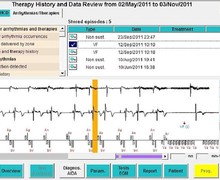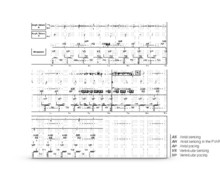Noise oversensing in the atrial lead
Tracing
Manufacturer Biotronik
Device Remote monitoring
Field Periodic Egm
N° 5
Patient
This 55-year-old man received an Evia DR-T dual chamber pacemaker for paroxysmal complete atrioventricular block; periodic recording of EGM.
Graph and trace
Telecardiology tracing
The 3 channels that are displayed for 12 sec are 1) the markers with the time intervals, 2) the atrial sensing channel and 3) the right ventricular sensing channel.
- oversensing of noise on the atrial channel; alternating cycles classified As, Ars and Ars (FFP = far field protection);
- the pacing mode is DDIR after a mode switch;
- end of atrial oversensing; AS-VS cycles with long PR interval;
- switch to DDDR mode and AS-VP cycles.
Other articles that may be of interest to you

EGM recordings

EGM recordings





The atrial lead impedance was normal and the capture threshold was satisfactory. Therefore, the lead was not revised. Oversensing at the level of the atrial lead can, as in this case, cause an inappropriate automatic mode switch because of erroneous diagnosis of atrial arrhythmia. In a defibrillator, it can also interfere with discrimination based on the counts of atrial and ventricular electrograms during tachycardia. This dysfunction, if frequent, must be eliminated in a defibrillator recipient: